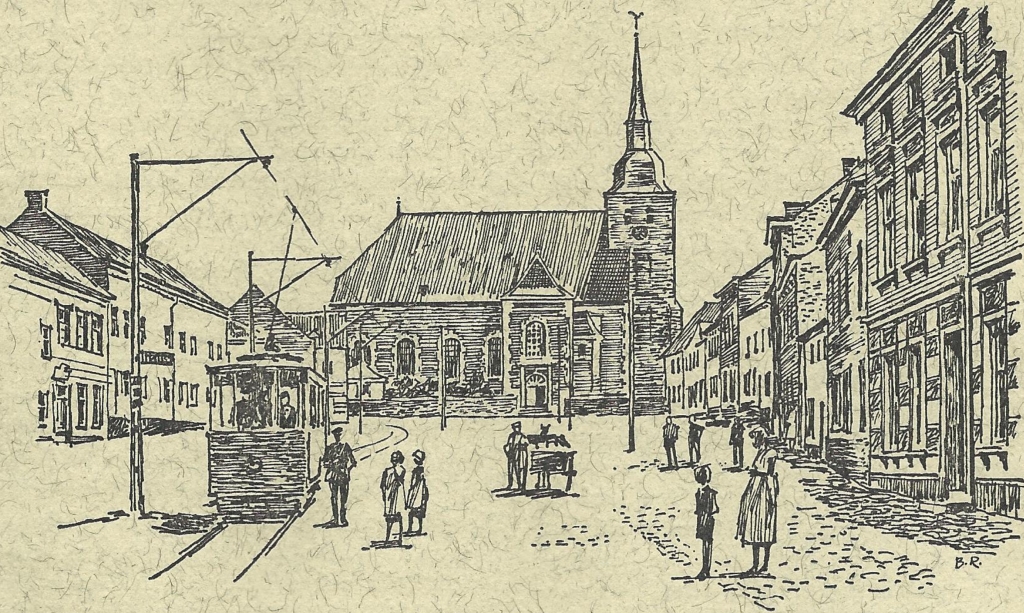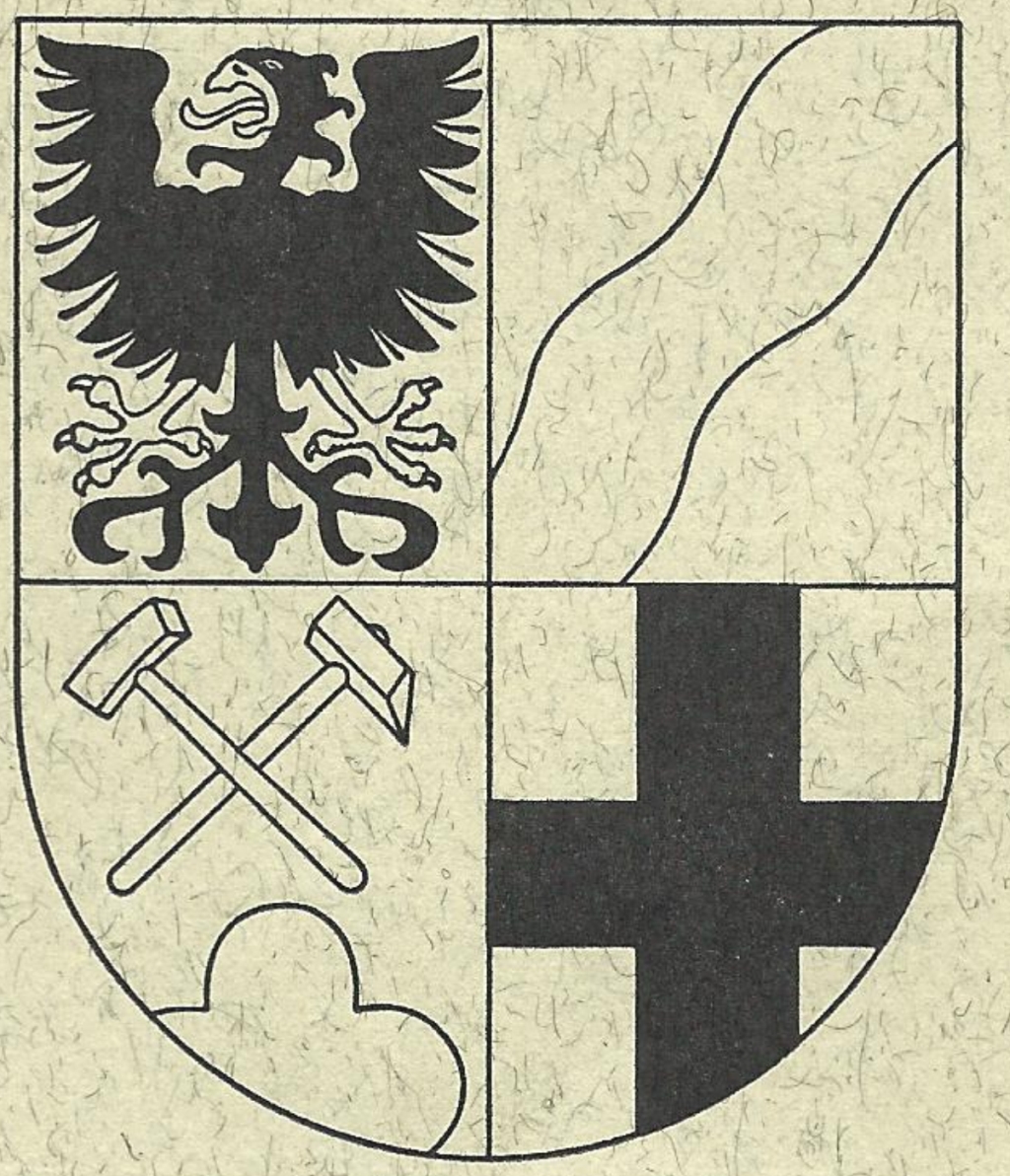Due to the passive resistance of the authorities and the population against the occupying powers, the occupied Rhineland was completely cut off by the rest of Germany after the First World War. Many workers became bread-less during that time. Inflation did the rest to make poverty and hunger more and more palpable.
When the need had risen to the highest, many unemployed people in Würselen moved in front of the town hall and demanded permission to require livestock, cereals and food from farmers and businessmen. Since they could not be given this permission, the unemployed, in desperation, resorted to self-help and get what they needed for themselves and their families to live.

Würselen Market Church of St. Sebastianus at the turn of the century
With the exception of a few years, Würselen was occupied by Belgian troops almost continuously until 1930. The costs of this occupation were considerable.
Their true costs, however, are difficult to estimate, as the billions expected during inflation confuse the picture. In 1923, for example, 41 trillion 687 billion marks of crew costs must be raised in Würselen.
It was not until 30 November 1930, twelve years after the end of the First World War, Würselen was finally cleared by the occupying forces.
Despite the serious times in which one lived at that time, a story handed down from 1923, about which one would still smile today. The story reports how the deputy mayor of Würselen stopped the separatist to capture the town hall. The separatist movement, which allegedly campaigned for a "free, independent Rhineland," had barely appeared in Würselen until then.
Now, however, one of their emissaries had turned up in Würselen and tried to find followers. To provoke the authorities, he struck two posters at City Hall calling out the "Rhenish Republic." When an official banned him from doing so, he fumbled around with a gun, shouting wild threats and eventually disappeared to find reinforcements.
That incident prompted the deputy mayor to order heightened alert to gather all police officers - little enough - at City Hall. In fact, on the night of October 22-23, 1923, nearly 300 separatists appeared to storm the town hall.
The besieged opened a barred window in the town hall door, giving the separatists an opportunity to take a look inside. What they saw there had to make the blood freeze in their veins. City Hall was seemingly teeming with heavily armed police. In reality, however, it was only a handful of officials who were constantly running back and forth in the hallway with guns on their arms, giving observers the impression of large numbers.
And as for the rifles – they were nothing more than dummies, wooden rifles that belonged not even to the police but to a gun-fraternity, as police were hardly allowed to have proper weapons at the direction of the occupation.
The deception, however, succeeded excellently: The separatists did not dare to fight against such power and withdrew again. In Würselen, after years, there was still a laugh about this affair, in which officials had once proved that they are capable at all times to defend their city even with a fake.
And you could laugh all the more heartily at it, because during these difficult postwar years, there was little reason to laugh. Even an event that would certainly have been celebrated with great joy in difficult times could not arouse the right mood in the occupation period:
In 1924, Würselen, now grown to around 14,500 inhabitants, became a city.
With particular pride, one could now show the city coat of arms. In its first field, the black imperial eagle spreads its swings and recalls the medieval affiliation of Würselen to the Aachen Empire.
The second quarter area of the coat of arms fills a green field with silver wave beam. It refers to the geographical position of Würselen on the river Wurm, which is also expressed in its city name.
The third, equally green field shows silver mallets and iron with golden stems over a golden tribberg: Symbol of the coal mining that has determined for centuries the economic life of the city.
Finally, in the last quarter, the colorful coat of arms in the silver field contains a black beam cross indicating the former ecclesiastical affiliation of the village to the archbishopric Cologne.

The Würselen City Coat of Arms
With the coat of arms alone, however, it was not enough. The Würselen elevation to a city brought numerous new tasks in the social, cultural and structural fields. For Würselen in particular, the question of spatial planning and urban design was not easy to solve, because the city does not have an actual center, around which the community of living and settlement could grow in organic construction.
Schweilbach, Scherberg, Morsbach and other districts already had independent settlement tendencies as Franconian individual goods or market cooperatives. Even the common Würselen-Parish Church, the most important center of the medieval community, was able to take part in local politics. Hardly bringing the villages closer to each other.
It therefore took all the efforts of the Council and the administration to weld Würselen together into an organic whole. The decisive factor in this was the structural planning, which was initiated in 1934 and 1939 by the acquisition of the industrial site between Krefelder Straße and Elchenrather Straße.
In the meantime, with the takeover of the power by the rulers of the Third Reich, drastic changes had also taken place in the communal. Many upright men were removed from their posts and positions by the new masters for alleged "political misconduct", especially in the mayoralty there were numerous terminations, permits and dismissals.
The trade union organizations had already been disbanded in 1933. The political parties had disbanded themselves later that year under pressure from the National Socialist leadership. The activities of the confessional youth associations were severely restricted in 1934. In 1938, the fate of the dissolution also hit the Youth Association and the Ketteler Association. The National Socialist organizations now took their place.
As early as 1929, local groups of the Nazi Party had been founded in Würselen and Morsbach, which were grouped together into a local group in 1935. Formations of the SA and SS, the Hitler Youth and other political associations completed the appearance of the ruling state party.
In 1936, the National Socialist institutions represented in the district of Aachen were merged into Würselen. Würselen becomes the seat of the district management of the Nazi Party in the district of Aachen. A year later, the banner site of HJ-Bannes Aachen-Land also settles in Würselen. This has put the city at the heart of political life in Aachen county - a dubious honor thinking of how the National Socialist spirit began to have an impact in the various areas of daily life.
There were not only torchlight processions and chants, May celebrations and children's landings winter aid collections, days of the Wehrmacht and stew Sundays. All this still looks comparatively harmless compared to the complete political alignment in all fields, against slander and denunciation, and the absolute suppression of any political opinion that is somehow different.
All officials and teachers are obliged to make a Hitler salute, teachers must take their oath to the leader, the crucifixes disappear from the classrooms, clergy are no longer allowed to give religious lessons in schools. From the official seals, the city coat of arms is cut out and replaced through the empire Eagles and the swastika. Numerous squares and streets are renamed and now carry out the names of the political greats of the Third Reich.
Soon the manifestations in which the new empire is embodied include the consequences of the Second World War, the bread, fat, sugar, meat and nutrient cards, the nocturnal aviator alarms, the droning of the flak guns. Soon orders are required like this: In the event of a warning after midnight the next morning, the instruction in the classes in schools will not take place.
Soon the schoolrooms will be occupied with soldiers or with men from the Todt organization working on the Westwall. Soon, as part of a "general Reichaction," there will be an order to transport all Jews resident in Würselen to Haaren-Hergelsmühle, from where their further fate leads into the unknown.
Please observe the copyright of the city of Würselen.
For more information see here.
Some comments and explanations have been added.Such information is presented as follows:
Comments and explanations go here.

